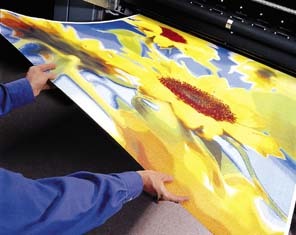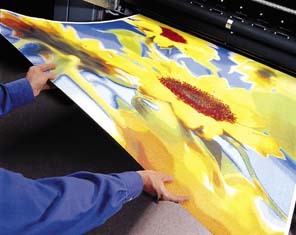Vehicles + Vinyl
Why Sticky Stuff Sticks
Tack, adhesion and other pressure-sensitive characteristics
Published
18 years agoon

Early in my career, listening to technical presentations about pressure-sensitive materials was excruciating. The jargon — terms such as crosslinking, dyne levels, peel, quick stick and wet out — was totally foreign. Sometimes, I must have resembled a wide-eyed, yet dumbfounded, cocker spaniel, with my head listing to one side as I attentively heard the words, but didn’t quite grasp their meaning. Understanding pressure-sensitive materials can be challenging, even for those with considerable experience. Pressure-sensitive constructions combine various components: adhesives, release liners, facestocks and carriers. The extensive range of adhesive-coated films, foils, papers and foam products, sold within the graphic-arts industry, includes cast and calendered vinyl, metallized specialty films, unsupported transfer adhesives, overlaminates, premasks and application tapes, double-sided foam tapes and supported mounting tapes. Few people understand the basic principles of pressure-sensitive materials because few manufacturers have formal training programs. And many existing programs aren’t very effective. This column will answer signmakers’ questions about pressure-sensitive materials by outlining some basic concepts and translating some jargon. Hopefully, you’ll baffle and impress your peers with newly acquired vocabulary and technical expertise. All about adhesives Simply put, an adhesive is any material that bonds two substrates. The egg yolk that fuses my plates together when I don’t wash the breakfast dishes is an adhesive. The sap that oozes from a cut pine tree is a common example of a natural adhesive. Natural latex — the milky fluid that comes from plants, such as rubber trees — is used in making the adhesive in your shop’s application tape. However, the scarcity of natural rubber during World War II gave rise to the creation of synthetic adhesives, including manufactured rubber and acrylic. Synthetic adhesives are related to plastics. Plastics and rubber adhesives — both synthetic and natural — comprise gigantic molecules, called polymers. Polymers comprise thousands of small molecules, called monomers. The chemical reaction that combines monomers into a single macromolecule is called polymerization. The polymerized synthetic resin, used in the manufacture of adhesives, used in cast or calendared vinyl, for example, is an acrylic resin. Macromolecule chains, formed in the polymerization process, can be joined together by bonds called crosslinks. The degree of crosslinking within an adhesive’s polymer chains affects its internal, or cohesive, strength. Cohesive, of course, means that material sticks to itself. A highly crosslinked adhesive typically has more memory. As such, if you apply pressure to an adhesive and stretch it in one direction, this type of adhesive has enough elasticity — or memory — to return to its original state. As crosslinking increases, the adhesive’s viscosity increases. Viscosity is the friction (or resistance) that occurs when layers of fluid slide against each other. Harder, viscous adhesives exhibit lower initial tack, making them ideal for hot-weather applications. Conversely, adhesives with less crosslinking are softer and flow more readily, with higher tack, but lower ultimate adhesion. Stickier vinyl doesn’t adhere as well as less tacky material. While this might sound like some Zen riddle from an episode of Kung Fu, it’s one of those strange, but true, paradoxes of life. Tack and adhesion aren’t the same. The macromolecular structure also affects how the adhesive performs. Generally, adhesives with long molecules are harder, yet more pliable, and build quickly to maximum adhesion. It’s difficult for these long, gangly molecules to arrange in an orderly pattern. Instead, they’re like a tangled plate of spaghetti, which is good. The molecules’ entanglement creates greater internal strength, compared to polymers arranged in an orderly, but stiff, crystalline structure. High energy Pressure-sensitive products work a little differently than other types of adhesives, such as contact cements, cold glues, hot-melt glues, epoxies and silicones. Diverse adhesives bond to substrates differently. When I worked in the packaging industry, I dealt with cold glues that seal corrugated boxes or folding cartons. They formed a bond, in part, by being absorbed by the paper substrate. Other adhesive bonds form through a chemical reaction between the adhesive and adherent (the material to which it’s trying to stick). Pressure-sensitive adhesives bond by molecular attraction, then mechanically interlock with the substrate. During this process, the adhesive flows into the substrate’s microscopic surface pores. To form a strong bond, the adhesive must readily flow over — or "wet out" — the substrate’s surface. The degree of wet out depends on the forces pulling in opposite directions. One force is the natural molecular affinity between two different materials. The adhesive’s internal forces fight this magnetic attraction. The substrate’s surface energy determines how strongly it attracts the adhesive. High-surface-energy materials have microscopic pores with higher and more pronounced peaks and valleys than a low-energy material’s smoother surface. The table below lists where some common signmaking substances fall within the energy spectrum (see Table 1).
| Table 1: An Energy Comparison | |
| Here’s a list of selected high- and low-energy materials, with their corresponding dyne levels (numerical values that represent surface energy). | |
| Low-energy materials | |
| Substrate | Dyne Level |
| Polystyrene | 36 |
| Polyethylene | 31 |
| Polypropylene | 29 |
| High-energy materials | |
| Substrate | Dyne Level |
| Stainless steel | 700-1,100 |
| Glass | 250-500 |
| Polyurethane paint | 43 |
| Polycarbonate | 42 |
| Rigid PVC | 39 |
| Acrylic | 38 |
Technical and product managers contrast a car’s newly waxed finish with an unwaxed finish to describe how an adhesive wets-out on low-and high-energy surfaces. Low-energy surfaces are similar to a newly waxed car; just as water sprayed on the surface beads up on the wax, the adhesive beads out on the substrate. On an unwaxed vehicle, the water spreads out. Similarly, an adhesive readily wets out on a high-energy surface. You can easily see wet out on an unwaxed car; however, an adhesive’s microscopic wet out can’t be seen. Time, temperature and pressure impact pressure-sensitive materials’ wet-out properties. As the adhesive continues to flow naturally into the microscopic pores, ultimate adhesion increases. Rising temperatures accelerate this process; predictably, colder temperatures retard the process. At room temperature, pressure-sensitive material starts to wet out after pressure is applied. Room-temperature application serves as the ideal environment. Sometimes, pressure-sensitive vinyl sticks without pressure, resulting in graphic deformation. When this happens, the term used (other than the litany of expletives that the frustrated and angry installer utters) is pre-adhesion. Other times, pressure-sensitive vinyls won’t stick no matter how much pressure you use, which occurs due to numerous reasons. For example, adhesion failure often occurs when you’re trying to apply a graphic in cold weather. Mishaps also occur frequently when the surface isn’t properly cleaned, or if the adhesive doesn’t mesh with the application substrate. For example, acrylic adhesives don’t wet out on untreated polypropylene and polyethylene. Stumped? Read the instructions. To select the best pressure-sensitive product for a particular application, consider the environment confronting the tape or vinyl. Will it encounter UV light, extreme heat or cold, or exposure to water and chemicals? Application temperatures, durability requirements and cost are other factors to consider. To avoid problems with vinyl or any other pressure-sensitive material, check its specs. The manufacturer’s product-information bulletin, and application instructions should provide all the information you need, including application and service-temperature ranges, peel adhesion, cleaning recommendations and information regarding application surfaces. If you still have questions, call your distributor or the manufacturer. Here’s a list of some things that can affect adhesion: * Substrate contamination. The surface must be clean and dry. If dirt, oxidation, plasticizers or release agents contaminate the surface, adhesion failure often follows. * Surface texture. Bonding a sign or nameplate to a rough surface requires thick, double-sided foam tape or transfer adhesive. * Substrate porosity. Porous sign substrates should be sealed. Otherwise, any moisture absorbed by the substrate could adversely affect the adhesive bond. * Thermal expansion. Substrates with different rates of expansion can break the adhesive bond. One such example would be mounting an expanded PVC sign to a metal building fascia. The sign blank expands and contracts at a much greater rate than metal.

SPONSORED VIDEO
Introducing the Sign Industry Podcast
The Sign Industry Podcast is a platform for every sign person out there — from the old-timers who bent neon and hand-lettered boats to those venturing into new technologies — we want to get their stories out for everyone to hear. Come join us and listen to stories, learn tricks or techniques, and get insights of what’s to come. We are the world’s second oldest profession. The folks who started the world’s oldest profession needed a sign.
You may like

6 Sports Venue Signs Deserving a Standing Ovation

Hiring Practices and Roles for Women in Sign Companies

Avery Dennison Adopts Mimaki Printer for Traffic Sign Print System
Subscribe

Bulletins
Get the most important news and business ideas from Signs of the Times magazine's news bulletin.
Most Popular
-

 Tip Sheet3 days ago
Tip Sheet3 days agoAlways Brand Yourself and Wear Fewer Hats — Two of April’s Sign Tips
-

 Business Management1 week ago
Business Management1 week agoWhen Should Sign Companies Hire Salespeople or Fire Customers?
-

 Women in Signs2 weeks ago
Women in Signs2 weeks ago2024 Women in Signs Award Winners Excel in Diverse Roles
-

 Real Deal4 days ago
Real Deal4 days agoA Woman Sign Company Owner Confronts a Sexist Wholesaler
-

 Editor's Note1 week ago
Editor's Note1 week agoWhy We Still Need the Women in Signs Award
-

 Line Time2 weeks ago
Line Time2 weeks agoOne Less Thing to Do for Sign Customers
-

 Product Buying + Technology1 week ago
Product Buying + Technology1 week agoADA Signs and More Uses for Engraving Machines
-

 Women in Signs4 days ago
Women in Signs4 days ago2024 Women in Signs: Megan Bradley















